 Disclosure: RIDE Adventures is a participant in the Amazon Services LLC Associates Program as well as other affiliate programs, designed to provide a means for us to earn fees by linking to Amazon and affiliated sites at no extra cost to you. Please see our Disclosure for more details.
Disclosure: RIDE Adventures is a participant in the Amazon Services LLC Associates Program as well as other affiliate programs, designed to provide a means for us to earn fees by linking to Amazon and affiliated sites at no extra cost to you. Please see our Disclosure for more details.
You've got plenty of choices for an adventure motorcycle helmet in 2025... but what really makes a helmet worth your hard-earned money?
Adventure helmets are what you get when a nice, respectable touring helmet has a few too many and wakes up next to a Monster Energy-swilling motocross lid.
An abomination born from an unholy union, the ADV helmet seemed doomed to fail when it first hit the market, yet today it's become widely accepted as the weapon of choice for all-terrain riders.
So what makes an adventure motorcycle helmet worth buying and how should you choose one for yourself? We'll cover that (as well as our favorite options) in the article below.
Quick List of Adventure Motorcycle Helmets
| Helmet: | Summary: | Price: |
|
|
Premium materials, precision manufacturing, and industry-leading protection meet a new, wider fit. | CHECK PRICE |
|
|
Super lightweight carbon fiber shell with massive ventilation and premium components. | CHECK PRICE |
|
|
Stable and quiet at speed while still offering excellent offroad manners and uncompromising safety. | CHECK PRICE |
|
|
Affordable and outstanding off-road thanks to lightweight shell and excellent ventilation. | CHECK PRICE |
|
|
Another budget-friendly option that includes a drop-down sun visor and dual safety certifications. | CHECK PRICE |
|
|
A more affordable version of the Krios Pro that weighs less but has fewer features. | CHECK PRICE |
|
|
A full 3K carbon shell and Pinlock visor at a fraction of the cost of competitors. | CHECK PRICE |
|
|
Pound-for-pound the best modular adventure motorcycle helmet around. | CHECK PRICE |
What Makes A Good Adventure Motorcycle Helmet?
About 20 years ago, Arai invented the adventure motorcycle helmet when they dropped their original XD model to a... lukewarm... reception.
The public didn’t really know what to make of it.
Some folks took it as a “supermoto” helmet thanks to its dirt-meets-street styling. A few testers even tried using it on the track with less than encouraging results.
That was back in 2003. Lucky for us, Arai knew they were on to something, and stuck to their guns, introducing an improved XD2 in 2005.
The helmet started popping up in ADV forums more and more, and slowly but surely the style began growing alongside the dual sport segment in general.
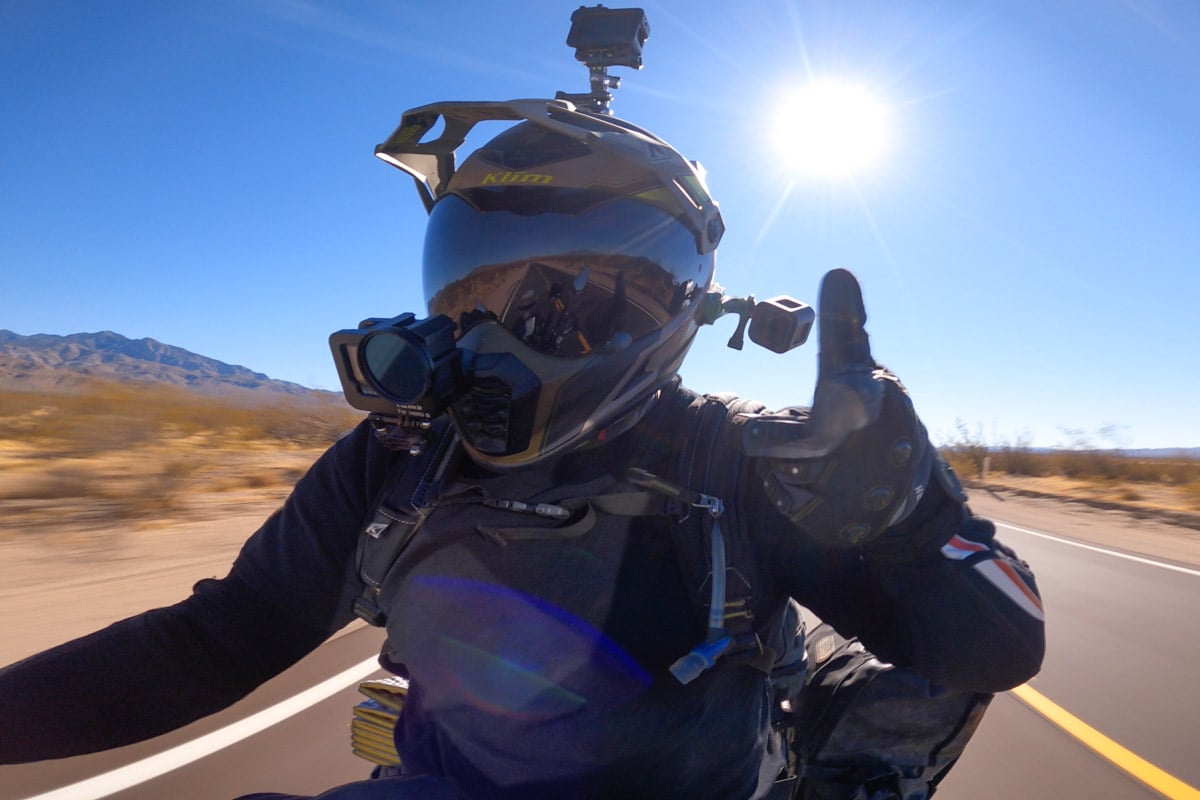
"Garrett our video dude with the full camera set up on his Krios Pro"
By the time the XD3 was introduced in 2008, the adventure motorcycle craze was well underway, and every major helmet manufacturer in the market had an ADV lid in the works.
Arai’s current XD5 is still one of the best adventure helmets on the market, and many consider it the benchmark in the industry.
In the article below we take a look at what makes an adventure motorcycle helmet like the XD5 “good” and see how well the more budget-friendly helmets in the market today compare to Arai’s gold standard.
Our Take On Adventure Motorcycle Helmets
When the original Arai XD was released, a few key features made it unique. Most notable was the fact its shell was shaped like a motocross helmet.
What I mean by that is the XD had an extended chin bar, a massive eyeport, and a sizable sun/dirt/roost peak jutting out the front. We consider all of those things essential to a good adventure motorcycle helmet.
In addition to the overall form of the helmet, there are a few other features that we consider must-haves to sit at the ADV table:
- Compatible with goggles (preferably with the shield up or down)
- Flow enough air for comfortable off-road use
- Good enough aerodynamics for highway speeds
- Significantly quieter at highway speed than a motocross helmet
Generally speaking, any adventure motorcycle helmet is going to be a tradeoff between touring and off-road features.
Even some of the quietest ADV helmets out there like Shoei’s Hornet X2 simply don’t compare to the sarcophagus-level quiet of touring helmets like the RF-1200.
Still, we prefer helmets in this segment to be reasonably quiet (earplugs should be optional, not mandatory) on the tarmac without sacrificing too much ventilation for sweaty off-road shenanigans.
The choice of whether or not to wear goggles is often debated, but anytime you’re riding through areas that are: (a) hot, and (b) dusty, you’ll wish you could ride visorless without sandblasting your retinas in the process.
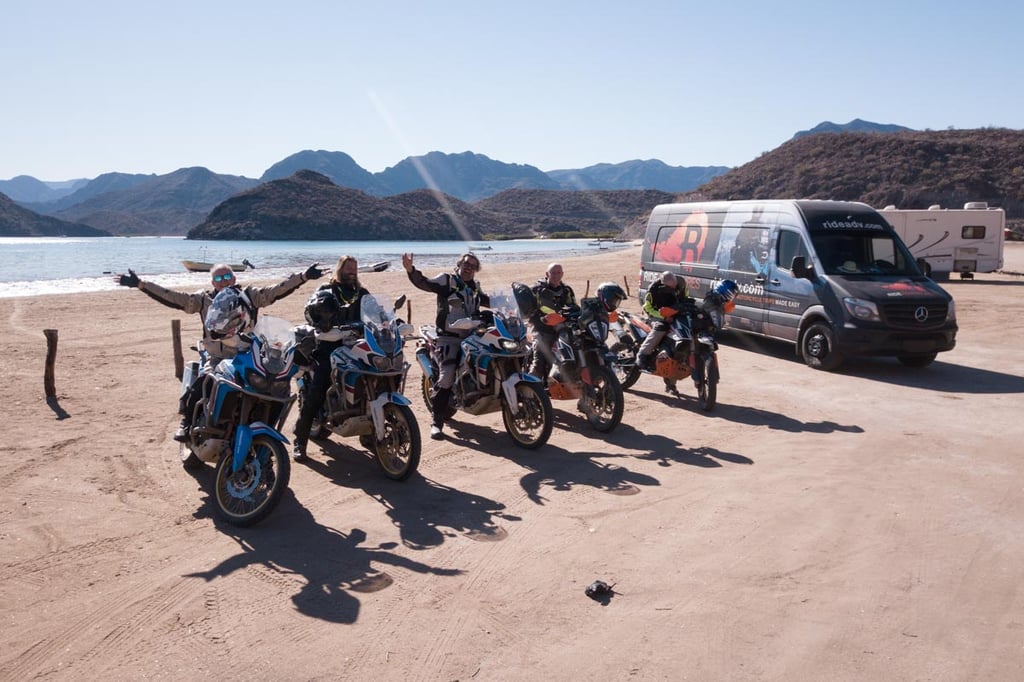
"Views from one of our popular tours on the Baja peninsula."
We do a fair amount of desert riding like this on our “Baja On Down” tour, and can’t recommend goggles enough out there.
Assuming all that sounds reasonable to you, here are some of our favorite helmets that check all those boxes.
Our Favorite Adventure Motorcycle Helmets of 2025
Although the ADV helmet market has blown up over the past decade, it’s still a relatively small offering compared to segments like touring or racing helmets.
For the list below we included both budget picks and premium offerings, but weeded out lids that are both cheap and cheaply made.
*(helmet number order is random)
1. Arai XD5
First on this list is the latest version of the helmet that started it all, Arai's new XD5. The XD5 replaces the popular XD4, which was an excellent helmet by any measure, but also was also getting long in the tooth having been introduced back in 2012.
As previous XD4 owners/enthusiasts ourselves, we'd sum up the changes as follows: the XD5 is wider between the ears, shorter front to back, and gets a significantly improved face shield over the outgoing helmet.
We say improved for two reasons. The first is that overall optical clarity is much better, and the peripheral distortion often experienced on the XD4 is gone entirely.
The second reason is that the new shield is Pinlock compatible (the old one wasn't), and Arai even includes a Pinlock insert in the box. Aerodynamics and road noise are consistent with the outgoing version, although ventilation at the chin has improved slightly.
Our biggest issue with Arai's flagship adventure motorcycle helmet is that it gets a whopping $200 increase over the previous version, bringing the starting price to well over $800.
We'll also note that because the shape of the helmet itself has changed, previous fans of the outstanding XD4 may find themselves at odds with the wider/shorter fit.
PROS |
CONS |
|
|

CHECK PRICE:
Arai XD5
2. Klim Krios Pro
Klim heard the prayers of the adventure motorcycle community and launched the upgraded Krios Pro helmet in 2019.
They kept all the features riders loved, fixed all the things they didn’t, and added some serious technology to boot. The superlight carbon fiber shell is still there, for instance, as are aerodynamic (and removable) peak and goggle-friendly shield.
The chinbar vent got a much-needed update, which resolved the achilles heel of the original Krios. Klim also incorporated Koroyd impact protection into the Pro model. That’s a big deal.
If you’re not familiar with the folks at Koroyd, they’ve developed an impact-absorbing material made from heat-welded hollow tubes (you may have seen their bright-green honeycombs peeking out from select motocross or mountain bike helmets) that outperforms traditional EPS foam protection.
The Pro also has magnetic Fidlock helmet straps, which allow you to take your helmet on and off with gloves without fumbling with any D-rings.
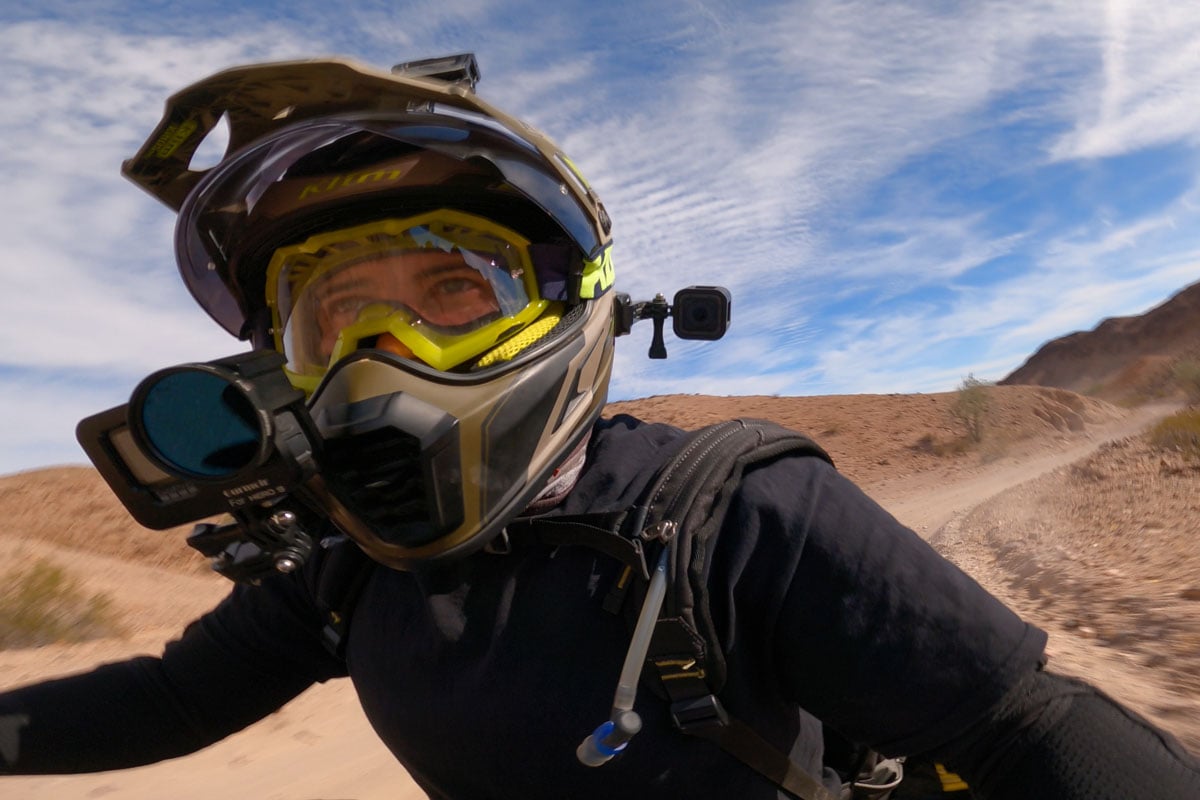 "Garrett our video dude, ripping on tour in the California desert with his helmet of choice the Klim Krios Pro"
"Garrett our video dude, ripping on tour in the California desert with his helmet of choice the Klim Krios Pro"
Aaaaaaand Klim threw in a Transition shield for the money, which seriously sweetens the deal considering it’s a $150 upgrade on the original Krios adventure motorcycle helmet.
Some folks who do a lot of transitioning in and out of dense woods don’t care for the Transitions system, but Klim includes a regular clear visor in the box with the Krios Pro as well, so those folks can just go ahead and keep it to themselves.
Still, if you’re not a Transitions fan, you might have a harder time justifying the extra cost of the Pro model.
PROS |
CONS |
|
|
CHECK PRICE:
Klim Krios Pro
3. Shoei Hornet X2
If you’ve been following our Youtube channel, you know we’re huge fans of Shoei’s latest version of their flagship adventure motorcycle helmet, the Hornet X2.
They’ve got their fitment down to a science (they offer four different shell sizes), their detachable peak feels non-existent even at highway speeds, and Shoei has also managed to make one of the quietest dual-sport style helmets on the market.
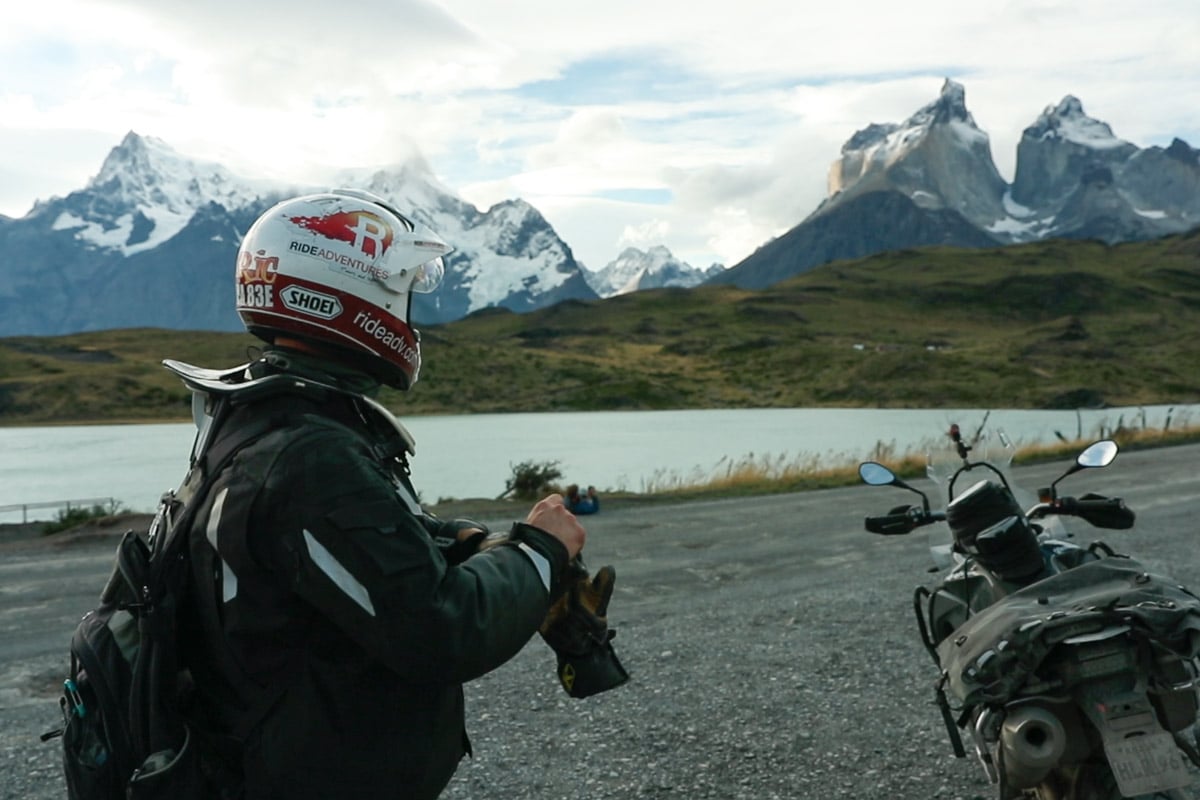 "Eric the founder of RIDE, tour guiding Patagonia equipped with his helmet of choice, the Shoei Hornet X2"
"Eric the founder of RIDE, tour guiding Patagonia equipped with his helmet of choice, the Shoei Hornet X2"
The visor works seamlessly with goggles and there’s no drama opening or closing it with them on. It also provides a huge field of vision and is “optically correct” meaning there’s little to no visual distortion along the bottom of the shield.
We don’t have any serious complaints about the Hornet if we're telling the truth. If we had to pick at something it would be the overall weight of the helmet, which is a full nine ounces heavier than the Klim helmets on our list.
The large vents along the helmet peak also allow a decent amount of sunlight through, which can create dark spots on your shield if you opt for the Transitions lens.
**Like that sticker wrap and RIDE Adventures design that you see on Eric's helmet in most of our videos and the photo above? Check out the custom graphics installations being done by Ryan Abbatoye Designs out of California.**
PROS |
CONS |
|
|
CHECK PRICE:
Shoei Hornet X2
4. Bell MX-9 Adventure MIPS
Bell’s MX-9 Adventure helmet is the most popular “entry-level” offering in the adventure motorcycle segment, and for good reason. At just 3.7 pounds, it’s lighter than everything else on our list except the Klim Krios.
It’s also the only helmet on our list using MIPS technology, which is a safety feature borrowed from the world of mountain biking.
MIPS (or Multi-directional Impact Protection System if you’re in no hurry) is a sliding plastic plate between the comfort liner and EPS layer of a helmet that reduces the rotational forces of impacts.
There’s a long scientific explanation you can dig into here, but the short explanation is it reduces the likelihood of brain injuries.
 "It's ubiquitous: we get at least one Bell MX-9 ADV in nearly every group we guide."
"It's ubiquitous: we get at least one Bell MX-9 ADV in nearly every group we guide."
It’s also worth mentioning here that the MX-9 Adventure keeps getting less expensive every year despite its safety improvements and ongoing popularity. It currently retails for around $230, which is an absolute steal for a namebrand lid that's both DOT and ECE certified.
The MX-9 Adventure also shares a good bit of its DNA with the popular MX-9 motocross helmet, which explains its aggressive good looks. The MX-9's ludicrous amount of airflow is also carried over, making the MX-9 Adventure ideal for off-road use.
Motocross-level ventilation is both a plus and a minus though, because some of the wide-open vents can’t be closed. That means you might feel a little moisture coming through them when riding in heavy rain, and the same goes for general road noise.
PROS |
CONS |
|
|
CHECK PRICE:
Bell MX-9 Adventure MIPS
5. AFX FX-41 DS
If you're digging the Bell MX-9's affordable price but prefer a lid with a few more bells and whistles, the AFX FX-41 DS is another budget-focused ADV helmet we'd recommend checking out.
The FX-41 is a touch heavier than the Bell at a little over 4 pounds and it doesn't flow air quite as well, but it outclasses it just about everywhere else. It's a little quieter, a bit softer, and even boasts a slightly larger field of vision to boot.
 The AFX FX-41's main selling point for most riders, however, is the fact that it includes a convenient drop-down sun visor as standard equipment.
The AFX FX-41's main selling point for most riders, however, is the fact that it includes a convenient drop-down sun visor as standard equipment.
And while you might expect AFX to have cut some corners on the safety front to keep this helmet affordable, we're happy to report it carries the same DOT and ECE certifications as the MX-9, too.
The main drawback of the FX-41 DS is the fact that while it's offered in a range of six sizes, AFX only manufactures two different shell sizes across the lineup.
That means the exterior of the helmet looks strangely oversized for most folks, but this cosmetic misstep is easy to overlook considering the AFX's asking price.
PROS |
CONS |
|
|

CHECK PRICE:
AFX FX-41 DS Helmet
6. Klim Krios Carbon
Klim’s Krios helmet was a huge step forward for adventure motorcycle helmets when it dropped in 2016.
It had a host of premium features like a hand-laid carbon fiber shell, a goggle-friendly visor system, and a peak that didn’t drag at highway speeds.
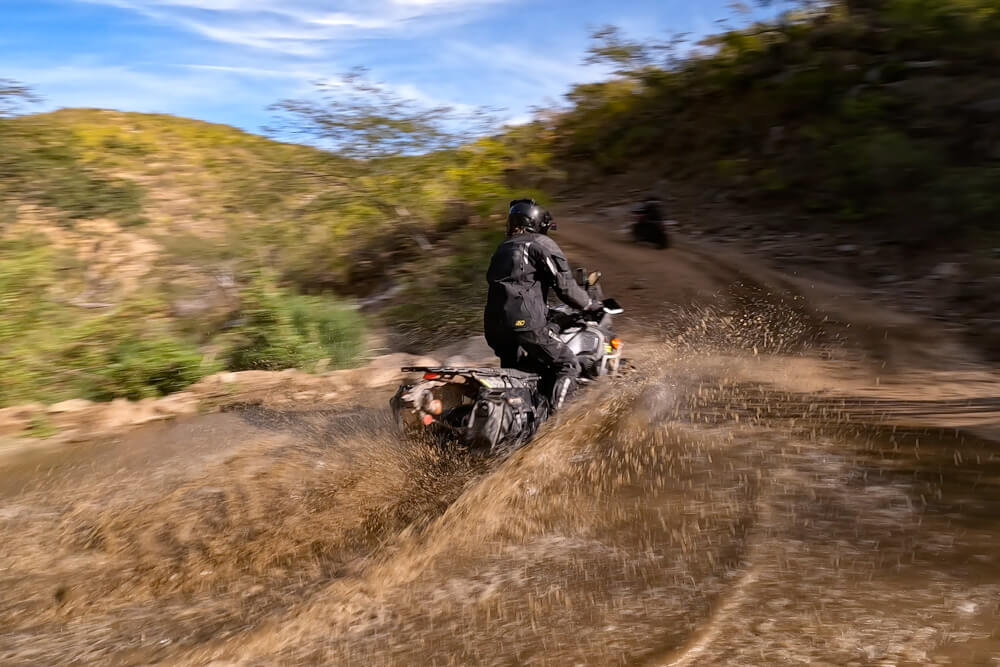
"One of the tour guides riding through some water on our Baja tour while sporting the Karbon helmet"
Weighing in at just 3.4 lbs, it was also one of the lightest helmets ever made, and hands-down the lightest adventure helmet you could buy.
The original Krios was almost perfect, save for one glaring detail: The ventilation just wasn’t on par with other helmets in the segment like Arai’s XD series.
The main culprit was found to be the chin bar vent, who’s massive intake vents shot air straight under the rider’s eyelids because it had no other path to travel.
Still, at about $100-$200 less than other “premium” adventure motorcycle helmets out there, this is a fantastic lid with premium features that punch way above the asking price.
PROS |
CONS |
|
|
Klim Krios
7. Scorpion XT9000
As a general rule of thumb, the words "affordable" and "carbon fiber" aren't to be used in the same sentence.
The folks at Scorpion are looking the change all that with their new XT9000 adventure motorcycle helmet, which sports a full 3K carbon shell for just $500.
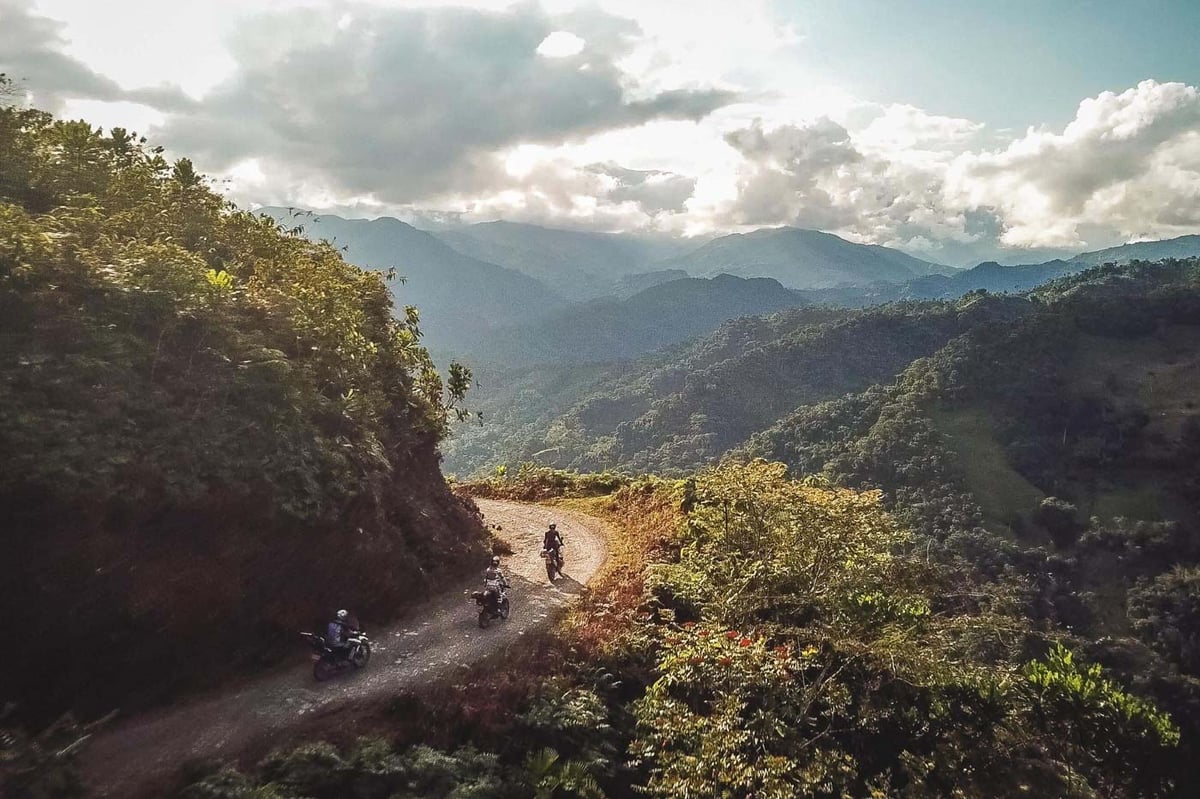
Now we know that $500 won't be everyone's idea of a budget-friendly helmet, but if lightness is what you're after, there's no better bang for your buck out there.
Even in a size large, the XT9000 tips the scales at a scant 3.6lbs, which is damn close to featherweights like the Klim and AGV above, and a cut above true "budget" carbon lids that typically aren't worth owning in the first place.
In addition to its low weight, we also love that the XT9000 sports Scorpion's typical above-average fit and finish, so despite the low asking price, no part of the XT9000 feels cheap.
The XT also includes the unique advantage of including an integrated action cam mount and chin plate accessory, so if you like to film while you ride, you'll find additional value there.
Other highlights include two Pinlock-ready face shields in every box (smoke and clear) as well as an actual Pinlock insert, so you won't need to spend extra for dead-reliable fog protection.
The XT9000 also borrows the unique "air-fit" system borrowed from the brand's flagship MotoGP lid, all but guaranteeing a perfectly snug fit for the most head shapes.
PROS |
CONS |
|
|
CHECK PRICE:
Scorpion XT9000
8. Scorpion EXO-AT960 (Modular)
If you’re a fan of the Bell MX9 Adventure’s price but prefer a modular helmet with some touring comforts, Scorpion’s EXO-AT960 is a great helmet for the money.
Modular systems have a huge fanbase, but options are severely limited in the adventure motorcycle helmet market.
The AT960 is pretty much the only choice out there for modular/adventure unless you’re looking to drop two or three times as much money on a Schuberth E1.

"Ricardo our tour guide in Colombia, taking a moment to enjoy the view"
Honestly though it’s a better helmet than the Schuberth for anyone planning on spending any real time off-road, as it vents a good bit more air and weighs in at the same four pound mark.
Four pounds puts it in the same weight range as the ultra-quiet Shoei, and while the Scorpion can’t quite compare to the Shoei in that regard, it’s much quieter than other adventure motorcycle helmets at this price point.
PROS |
CONS |
|
|
CHECK PRICE:
Scorpion EXO-AT960
Our Final Thoughts On What Makes A Good Adventure Motorcycle Helmet…
Ultimately, we feel the same way about helmets that we do about any other piece of adventure motorcycle gear: Safety is the priority, creature comforts are secondary.
But that’s good news for helmet shoppers because you actually don’t have to spend a ton of money to have a great ADV helmet with serious safety baked in.
I’m a huge fan of the Bell MX-9 Adventure, for instance, but I’m also willing to put up with some road noise to save a couple hundred bucks.
Helmets like the Arai and Shoei are 100% quieter with the visor down, and if that’s important to you, you should spend the money on it.
After all, you’ll be spending a lot of time inside your helmet on tours like our seventeen-day epic through Southern Peru. Had to fit in one more shameless plug since we live off tips from tours after all ;)
You really can’t go wrong with any helmet on this list. If your current helmet situation is less than confidence-inspiring, pick one up before your next ride and drop us a comment to let us know what you think.
Read More→
Shoei Hornet X2 Review: The Best Dual Sport Helmet Yet?
Klim Krios Pro Helmet: Long Term Owner Review





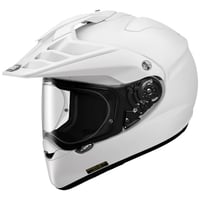
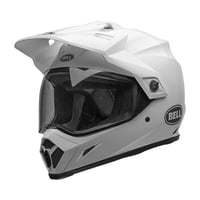

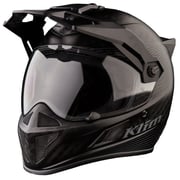
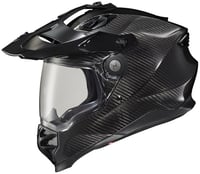








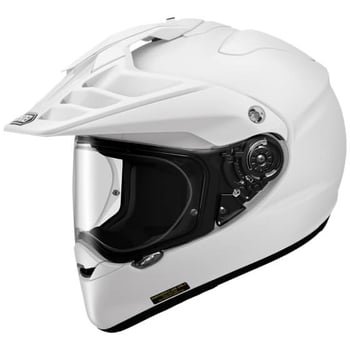
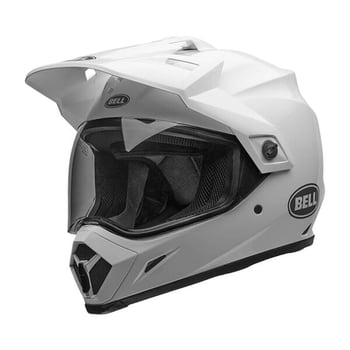

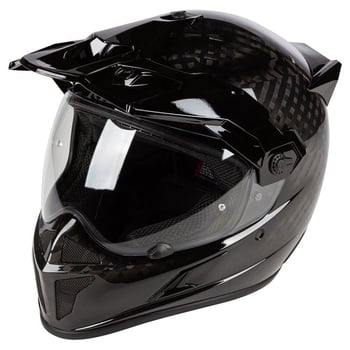


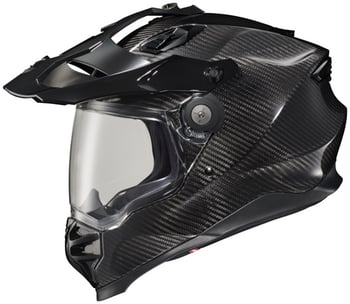

 "RIDE Crew
"RIDE Crew 
